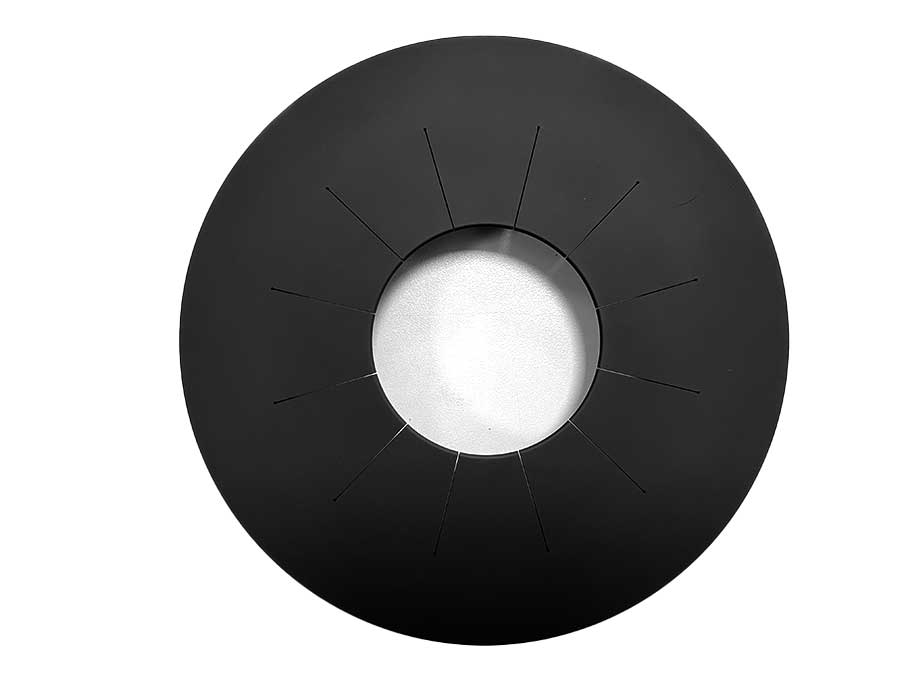- Functional0.88 absorbance |700°C resistance| Pa-3 no vacuum precipitation
Naxau black light absorbing (infrared radiation, etc.) nano-coatings are used for a variety of special demanding applications, such as 700° high temperature and light absorbing, or insulating, wear and corrosion resistant, or a combination of abrasion resistant and high bonding, no vacuum precipitation, and other requirements. NanoShield has C:CrCN carbon coatings with low micro-hardness and high light-absorbing rate, as well as metal oxide coatings with high hardness and high temperature resistance. NanoShield’s vacuum coating equipment can combine various ion sources to deposit a variety of film systems
PVD DEB Coating-Black High Temperature Absorbent-Insulating Coating-Air High Temperature Oxidation Resistant Non-Discoloring Series
DEB coating: 1-7 micron film thickness insulation parameters can be customized, 1800HV hardness, high temperature resistance over 700°, 300-400V breakdown resistance. NanoShield hard multifunctional coating series, welcome to sample test. Compared with CG9 carbon film series, suitable for hardness and abrasion resistance, high temperature absorption/insulation conditions.
It has an absorption rate of up to 0.84 or more for infrared and far infrared (0.8 for glossy surface, tested by Naxau Laboratory).
PVD CG9 Coating–Pure Black High Temperature Resistant High Absorbance-Insulation Coating Series–Black Titanium Decorative Plating
CG9 coating is a carbon film doped with Cr metal element, 800HV microhardness, 0.88 high light absorption rate after surface treatment, color value: L25-L30, 50V-150V breakdown resistance, high temperature oxidation prevention within 250°. Compared with DLC coating, anti-corrosion effect is slightly worse (CG9 coating without surface dense layer), but the value of blackness and high temperature resistance is better.CG9 is a kind of black titanium, can be made of hard film black decorative plating, suitable for stainless steel, aluminum alloy (plating priming), copper and other types of metal function or decorative needs.
CG9 is deposited by P1200 PeCVD sputtering process, which can realize low temperature coating within 200℃. It can even be coated on some high temperature plastics.
Up to 0.88+ absorption for mid-infrared. Need to do surface atomization treatment.

Light-absorbing coating applications
- Applicable materials: metal, glass, ceramics, temperature-resistant plastics above 150℃;
- Application conditions: Suitable for all kinds of ultra-thin, vacuum without precipitation environment, the requirements of the coating of high light absorption / extinction, high temperature resistance, insulation, high hard wear resistance, corrosion resistance and other needs.
- Other: This coating has abundant cases in stainless steel, molybdenum alloy, pure copper, aluminum alloy, logable alloy, pure gold (for high light absorption and high reflection), etc., and can be directly introduced into mass production;
| Model number | Absorbance | Conductivity (elec.) | Thickness | Surface hardness | Oxidation stability |
|---|---|---|---|---|---|
| DEB | 0.84 | Multimeter insulation | 3-8μm | 1800HV | 700-1000℃ |
| CG9 | 0.88 | 20MΩ | 3-8μm | 300HV | 250-300℃ |
High Temperature Resistant Light Absorbing Coatings FAQs
The DEB coating of Naxau is a R&D project that Lingxi has been following up for more than a year. There are two coating types, which are mainly for infrared and mid-infrared wavelength absorption, so they have a very good heat-absorbing effect, but with a film thickness of 3-7 micrometers and a metal-ceramic film, they basically don’t affect the heat dissipation. Currently absorbance 0.82-0.88, by the metal substrate temperature limitations, suitable for different coating types. If you need to be similar to the knife tool coating as wear-resistant, the absorbance will be further reduced to 0.76.
The NACLEX DEB Absorbent Coating is based on a tool plating process, which provides a higher level of absorption compared to other decorative plating coatings.Binding force (HF1-HF2)The product is characterized by higher film hardness (800-2000HV), better high-temperature stability (theoretically 1100°C for 30 minutes; 750°C for 6-10 hours), and no decomposition and no vacuum precipitation at 700°C, -5pa.
We are most likely to search for a materials research institute in zhejiang, light absorption can 99% above the super black coating, “the coating can be deposited on the surface of a variety of substrates, at the same time can realize the large area batch preparation, and can adapt to high temperature, low temperature, vacuum, liquid and other extreme service environment.” Unfortunately Lincy has not used them personally, but quite a few of my customers have approached them, and let’s just say the application working conditions are different. They describe their super black coating in terms of deposition and no weight gain, odds are it’s a vacuum coating process as well.
Lincy guesses that the coatings on the market are more oriented to decorative plating, so there will be a significant gap in high temperature resistance, abrasion resistance, bonding and more complex working conditions. Typically, decorative plating lacks a priming layer and has a distinct pick on the substrate.
There is also a nanotube technology that achieves the ultra-black light-absorbing coating effect. Inspired by this, assuming that this light-absorbing coating is plated on a femtosecond or microscopic corrosion surface, the absorbance should be significantly increased. Making microstructures of metal surfaces currently has very good applications in hydrophobic coatings, similar to the lotus leaf effect. Similarly, there should be a very good practical effect in the field of light absorption, which allows the light to go through multiple rounds of reflection and diffuse reflection, and cuts down the spillage significantly.
NaxauDEB coating is one of the few high-temperature oxidation-resistant light-absorbing coatings that has been mass-produced.
Yes. Currently has four types of customers and is in the use secrecy stage. Currently, it is mainly used in high-power lamps, medical nuclear magnetic equipment, mid-infrared absorption, and deep-space light absorption. In addition, this coating is a high-temperature-resistant insulation, which can be used in nuclear power, base station parts, and so on.
- Naxau DEB light-absorbing coating is a PVD vacuum coating process for incoming materials, where the workpiece is hang-plated in a vacuum furnace at 250-450°C, and PVD vacuum deposition is carried out.
- The price is calculated according to the amount of furnace. Usually 12,000-15,000 yuan a furnace; such as the largest size of the workpiece ≥ 800mm, plus 500 yuan outsourcing pre-treatment costs.
If you have the opportunity to proof with the oven, it is free of charge. - Currently, the maximum processing size is φ600x850mm, and for customers who do not require high light absorption and film thickness, the maximum size of the vacuum furnace can be expanded to φ680x1700mm.
- Specialized furnace, delivery time 2-3 days; sampling with the furnace, about 1 month due to irregular furnace opening.
It is possible that nano-alumina is a typical infrared absorbing material. Suitable porosity and surface roughness will further enhance the absorption effect. NANOXI light absorbing coating series, more importantly, has a certain wear resistance and high bonding force for industrial or special purposes, thus sacrificing part of the light absorbing absorption energy.
 Naxau PVD/DLC Vacuum Coating Equipment-IE
Naxau PVD/DLC Vacuum Coating Equipment-IE

